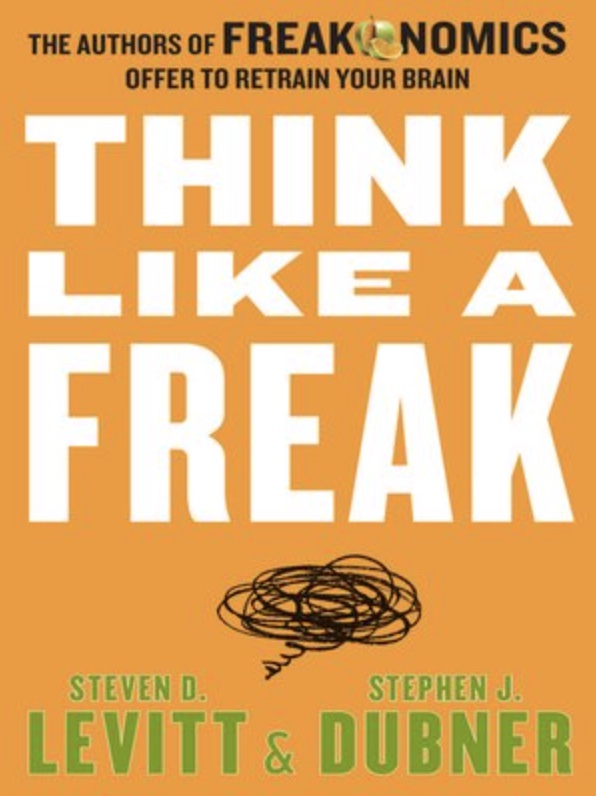Key Quote:
“Figure out what people really care about, not what they say they care about. Incentivize them on the dimensions that are valuable to them but cheap for you to provide.” (p. 135) — Steven Levitt and Stephen Dubner
Key Points and Concepts
“I Don’t Know!”
People are reluctant to say “I don’t know” because the cost of saying “I don’t know” is higher for the individual, and we have a tendency to protect our own reputation over that of the collective good (p. 29). “That’s a shame, for until you can admit what you don’t yet know, it’s virtually impossible to learn what you need to” (p. 20). Instead of denying your ignorance, say, “I don’t know, but maybe I can find out” (p. 48).
Don’t be afraid of the obvious. It can lead to questions you might otherwise not have asked (p. 93).
Set aside your moral compass to prevent it from clouding your vision: “When you are consumed with the rightness or wrongness of a given issue…it’s easy to lose track of what the issue actually is. A moral compass can convince you that all the answers are obvious (even when they’re not); that there is a bright line between right and wrong (when often there isn’t); and, worst, that you are certain you already know everything you need to know about a subject, so you stop trying to learn more” (p. 31).
The best way to get feedback is to experiment; however, places do not do this because of tradition, lack of expertise, and the fact that it requires someone to say, “I don’t know” (p. 39).
“If it takes a lot of courage to admit you don’t know all the answers, just imagine how hard it is to admit you don’t even know the right question. But if you ask the wrong question, you are almost guaranteed to get the wrong answer” (p. 49).
Finding the Answer
“Here is the broader point: whatever problem you’re trying to solve, make sure you’re not just attacking the noisy part of the problem that happens to capture your attention. Before spending all your time and resources, it’s incredibly important to properly define the problem—or, better yet, redefine the problem” (p. 52). For example, Kobasyashi broke the Hot Dog Eating Competition record not by asking, “How do I eat more hot dogs?” but rather “How do I make hot dogs easier to eat?” He experimented by trying out different ways to eat hot dogs (p. 61).
Refuse to accept limits, as they create artificial barriers. For example: if you decide to do 10 pushups, you might falter around 7-8, but if you say you will do 20, you’ll be able to get to 10 more easily.
Ask small questions rather than big ones—it makes your goal clearer and more concise. Small questions are less often asked and investigated, which allows for new territory to be explored. They allow you to make incremental progress instead
of struggling with the big problem—it is easier to change something small rather than something large.
People Respond to Incentives
People are more likely to do what others do. Public service announcements that highlight an undesirable behavior may actually legitimize the behavior as it shows that many other people are engaging in it. For instance, if a campaign against drunk driving emphasizes the prevalence of the behavior they are trying stop, the audience may interpret the message as others are doing it, so it’s okay for them to do it, too (p. 116).
Why do incentives fail? It’s easy to envision how you’d change the behavior of people who think just like you do, but the people whose behaviors you’re trying to change often don’t think like you—and, therefore, don’t respond as you might expect.
• There is a tendency to assume that the way people behave today is how they’ll always behave. But the very nature of an incentive suggests that when a rule changes, behavior does too— although not necessarily, as we’ve seen, in the expected direction (p. 134).
Rules for incentives: “Figure out what people really care about, not what they say they care about. Incentivize them on the dimensions that are valuable to them but cheap for you to provide.” (p. 135)
• Pay attention to how people respond; if their response surprises or frustrates you, learn from it and try something different.
• Whenever possible, create incentives that switch the frame from adversarial to cooperative. Never, ever think that people will do something just because it is the right thing to do.
• “Know that some people will do everything they can to game the system, finding ways to win that you never could have imagined. If only to keep yourself sane, try to applaud their ingenuity rather than curse their greed” (p. 135).
Think Like a Kid
Kids are harder to deceive than adults (p. 103). Adults are trained to follow cues that magicians use to distract the audience, whereas kids haven’t learned these rules so they are more likely to notice the subtleties in the trick. Adults are better at paying attention. Kids don’t have expectations as to how the world works so expectations aren’t turned against them. Kids literally see tricks from a different vantage point, which helps them notice things differently, as tricks are typically designed to be seen at eye level.
Set Up Tripwires
Teach your garden to weed itself or create a separating equilibrium: set up a trap so that the guilty ones will present themselves to you. For example, David Lee Roth’s brown M&Ms: the band Van Halen had a manual describing in detail all the steps involved in setting up the band’s equipment. In one of the many pages, it asked for absolutely no brown M&Ms in the green room snack bowl. This request for attention to detail allowed him to do a quick check to see if the venue followed directions carefully. If there were brown M&Ms, he would have to do a full check of the venue to ensure the safety of the setup (p. 142).
How to Persuade Others
When trying to persuade someone who doesn’t want to be persuaded, trick them using subtle cues instead of explaining to them about the “worthiness of a goal” (p. 172):
• “The first step is to appreciate that your opponent’s opinion is likely based less on fact and logic than on ideology and herd thinking” (p. 172).
• “Your argument may be factually indisputable and logically airtight but if it doesn’t resonate for the recipient, you won’t get anywhere” (p. 173).
• “Don’t pretend your argument is perfect” (p. 173). “If you want your argument to be truly persuasive, it’s a good idea to acknowledge not only the known flaws but the potential for unintended consequences” (p. 176).
• “Acknowledge the strengths of your opponent’s argument” (p. 177).
• “Keep the insults to yourself” (p. 180). Once you insult someone, you lose your power.
Use stories (not anecdotes) to fill out the picture to support your argument (p. 181).
• A story exerts a power beyond the obvious. “The whole is so much greater than the sum of the parts—the facts, the events, the context—that a story creates a deep resonance” (p. 183).
• “Stories also appeal to the narcissist in all of us… ‘Yes, I would have done that too!’ Or ‘No, no, no, I never would have made that decision!’” (p. 183).
• Stories capture attention and are good at teaching (p. 183). “A rule makes a much stronger impression once a story illustrating said rule is lodged in your mind” (p. 185).
The Upside of Quitting
People are reluctant to quit due to these forces biasing us against quitting (p. 191): Quitting is a sign of failure. Sunk costs (investments already made in the project). We focus more on concrete costs than opportunity costs (p. 191). What could you have done if you had done something else instead?
Sometimes, quitting is necessary because of limited resources. “Resources are not infinite: you cannot solve tomorrow’s problem if you aren’t willing to abandon today’s dud” (p. 192).
Failure can provide feedback (p. 192): “In medicine, or in science, [if] you go down a path and it turns out to be a dead end, you really made a contribution, because we know we don’t have to go down that path again… In the press, they call it failure. And so people are unwilling to innovate, unwilling to take risks in government” (p. 193).
The technology firm Intellectual Ventures has an invention lab that tests ideas from all over the world. Geoff Deane, who runs the lab, describes two forces that come to play when an invention makes it to the lab, “One force really wants to find a winner. The other one doesn’t want you to spend a ton of money or time on an idea that won’t be successful. The key is failing fast and failing cheap. That’s a mantra that comes out of Silicon Valley. I prefer the statement ‘failing well,’ or ‘failing smart’” (p. 194).
“A premortem tries to find out what might go wrong before it’s too late. You gather up everyone connected with a project and have them imagine that it launched and failed miserably. Now they each write down the exact reasons for its failure” (p. 199).
Levitt, Steven D., and Dubner, Stephen J. 2014. Think like a Freak. New York: Harper Collins

“If it takes a lot of courage to admit you don’t know all the answers, just imagine how hard it is to admit you don’t even know the right question. But if you ask the wrong question, you are almost guaranteed to get the wrong answer.”
Kids are harder to deceive than adults. Adults are trained to follow cues that magicians use to distract the audience, whereas kids haven’t learned these rules so they are more likely to notice the subtleties in the trick.
People are reluctant to quit due to these forces biasing us against quitting: Quitting is a sign of
failure. Sunk costs (investments already made in the project). We focus more on concrete costs than opportunity costs. What could you have done if you had done something else instead?
